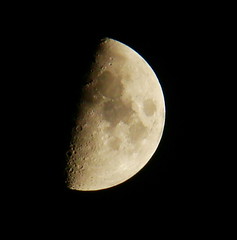Looming some 384.400 km (239,000 miles) from the Earth, with a diameter of 3476 km (2,160 miles) and a mass of 7.35e22 kg. shines the Moon. The Moon is the brightest object in the night sky and only second in brightness to that of the Sun. Its mean density is only 3.34 times that of water. It has no real atmosphere and no magnetic field of its own and is the only natural satellite of our planet Earth. In fact, the Moon is next to the largest moon in our solar system; the Earth and Moon can almost be said to be a double planet. The Moon undergoes extremes in temperature: it is alternately scorched to +110 degrees celsius during the day and frozen to -180 degrees celesius at night. Many of us have seen its eclipses and occultations. The Moon shines by reflected sunlight as it passes through each of its familiar phases and the Moon (with a little help from the Sun) also controls the ocean's tides.
Five hundred million years ago, the Moon summoned life out of its first home, the sea, and led it onto the empty land. For as it drew the tides across the barren continents of primeval earth, their daily rhythm exposed to sun and air, most creatures of the shallows perished—but some adapted to the new and hostile environment. The conquest of the land had begun.
The shifting patterns from light and dark, heat and cold, and the cyclical paths of the Sun, Moon, stars, and eclipses were pondered ever since our primeval ancestors first gazed out at the starry heavens. Their daily rhythm ruled each of the various stages of life, and their very survival.
Ancient cultures considered the flow of time to be a circle without beginning or end. Since people were mostly farmers, hunters and shepherds, they lived and worked closer to nature than in ages past. It was important that they knew the 'lore of the land' just to survive. They observed that the various phases the moon passed through in a month coincided with events transpiring in their environment. To this end, they learned to plant, fish, harvest, hunt, and make predictions, all by the light of the silvery moon.
Humanity seemed very little in control of the divine laws of nature. There were major and minor cycles of experience, and the mysteries of the heavens were a revelation of some divine principle of which they were a part. The ebb and flow of the seasons reflected life as a whole, in life, death, growth, rebirth and change. This was revealed to humanity in the metaphor of the Gods. They also paid careful attention to the eclipses of the Sun and Moon. Their basic assumption was that there is a sequence of consequences between events in the heavens and events occurring on the earth. ("As above, so below".) These observations formed the universal laws that are the foundations of ancient wisdom. The Moon and the Sun have been charged with certain attributes ever since the dawn of time. The Moon was the first universal measurer of time. The Moon symbolizes time, fate, spinning, wheels, weaving, cauldrons, and of course the Great Mother or feminine influence.
Besides spending a lot of time with my webdesign agency FRUITWISH.nl i like to explore the web, and sometimes i write in this blog about common and un common things

